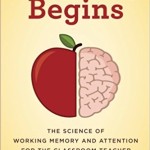It’s finals time!
As the promise of spring and summer days rolls in, the increase in sunshine can mean only one thing for students: assignments, exams, papers, and projects are due.
Not surprisingly, this time of year arrives with no shortage of stress for those with tight deadlines, writer’s block, computer glitches, or myriad other dilemmas inherent to the academic world.
And for those faced with the daunting sight of a blank page needing to be filled, I like to offer the charming words of Sylvia Plath: “let me live, love, and say it well in good sentences.”
Of course, taken from Plath’s novel The Bell Jar, the quote’s implied ease of eloquent composition belies much of the strife of writing. Which brings us to an important question: where do good writers come from? Or, better yet, how do children acquire the words that will eventually be put on paper to make them good writers (and to ace those finals)?
Given that language and literacy skills are ubiquitous, their development has been an interest of researchers for years. And it turns out that early language exposure has long-lasting implications for childhood skill growth.
Let’s Talk about School Talk
Hoping to better understand if the amount and type of vocabulary that preschool teachers use around their students would predict children’s language skills at kindergarten and beyond, Dickinson & Porche (2011) conducted a longitudinal study. [1]
The researchers observed and videotaped classroom interactions in a number of Head Start preschools. Teacher-child talk was then separated into several categories:
- teacher extending utterances were those times when teachers tried to keep conversation going by encouraging children to talk further;
- sophisticated vocabulary reflected the number of low-frequency or sophisticated words used by teachers;
- attention-related utterances were those times when teachers tried to gain or hold their students’ attention;
- correcting utterances arose when teachers corrected the accuracy of what students said;
- and analytic utterances during book reading happened when teachers prompted their students to explore reasons for characters’ actions or discussed the meanings of words.
The researchers also examined children’s literacy skills. To do this, the children completed tests targeting storytelling, receptive vocabulary, reading comprehension, and word recognition at both kindergarten and 4th grade.
Analyses showed that reading comprehension in 4th grade was positively related to preschool teachers’ use of sophisticated vocabulary and attention-related utterances.
As well, preschool teachers’ use of sophisticated vocabulary positively influenced 4th grade decoding skills.
Finally, a mediation model, or an indirect chain effect, emerged among preschool teachers’ sophisticated vocabulary, children’s kindergarten decoding skills, and children’s 4th grade reading comprehension. That is, students who had a preschool teacher that used more sophisticated vocabulary were better able to decode words in kindergarten, and in turn had better reading comprehension skills in 4th grade.
So, in essence, preschool teachers who used more varied words, and maintained their students’ attention to these words, seemed to provide more opportunities for their students’ language skills to grow.
Let’s Talk about Home Talk
Of course, no discussion of schooling’s impact on early skill development is complete without a look toward the home’s impact.
One such home-based study investigated the relation between socioeconomic status (SES) and children’s early language development. [2]
There were two primary hypotheses here:
- that SES-related differences in children’s vocabulary could be the result of SES-related differences in language-learning experiences;
- that maternal speech would mediate the relation between SES and child vocabulary development
33 high-SES families and 30 mid-SES families agreed to video record daily activities in their home and allowed researchers to transcribe them. Parent-child interactions were recorded twice, 10 weeks apart, and included such activities as getting dressed, eating breakfast, and playing with toys.
The researchers then used a variety of measures to analyze maternal speech.
They tallied word tokens (i.e., the number of different words used), word types (i.e., the number of root words used, such that using both ‘run’ and ‘running’ counted as one use), and word totals (i.e., the total number of words, even if some were used more than once).
They also counted the number of times the parent built upon something the child said (topic-continuing replies).
Finally, children’s vocabulary skill was assessed as a measure of productive vocabulary, or the number of word types used in an average 90-utterance speech sample.
These data showed that SES was significantly associated with both child vocabulary and maternal speech: high-SES mothers produced more utterances, more word tokens, more word types, spoke for longer periods of time, and produced more topic-continuing replies than did mid-SES mothers.
The average length of the mothers’ speech significantly predicted child vocabulary. And, the association between SES and child vocabulary became statistically weaker once the researchers subtracted maternal speech from the equation. In other words, the difference in vocabulary that the researchers found between the high-SES and mid-SES children was due (almost fully) to the differences seen in their mothers’ speech.
It seems, then, that SES-related differences in child-directed speech may arise from more general SES-related differences in language use. That is, the style of language use among higher-SES mothers appears to influence the way they talk to their children, which in turn affects the rate at which their children build their vocabularies.
Small Steps toward Big Words
These studies contribute to a large literature that suggests early language experiences have a substantial long-term impact on children’s language and literacy skill development.
So should parents and teachers grab the thesaurus in hopes that that their children will fast-track to the Dean’s List?
Probably not.
But a little mindfulness about how we (as parents, teachers, and/or caregivers) use our words around our youngest learners will probably go a long way.
In fact, studies have shown that even small increases in the richness of language that children are exposed to can have a lasting positive effect. [3]
So here and there, we can ask ourselves:
The next time I ask her to put her toys away, can I say it in a new way?
How can I push them to think about why the story character feels both happy and sad at the same time?
And my personal favorite: Am I saying this well, in good sentences?
References:
Connor, C.M., Morrison, F.J., & Slominski, L. (2006). Preschool instruction and children’s emergent literacy skills. Journal of Educational Psychology, 98, 665-689. [link]
Dickinson, D. K., & Porche, M. V. (2011). Relation between language experiences in preschool classrooms and children’s kindergarten and fourth-grade language and reading abilities. Child Development, 82, 870-886. [link]
Hoff, E. (2003). The specificity of environmental influence: Socioeconomic status affects early vocabulary development via maternal speech. Child Development, 74, 1368-1378. [link]




